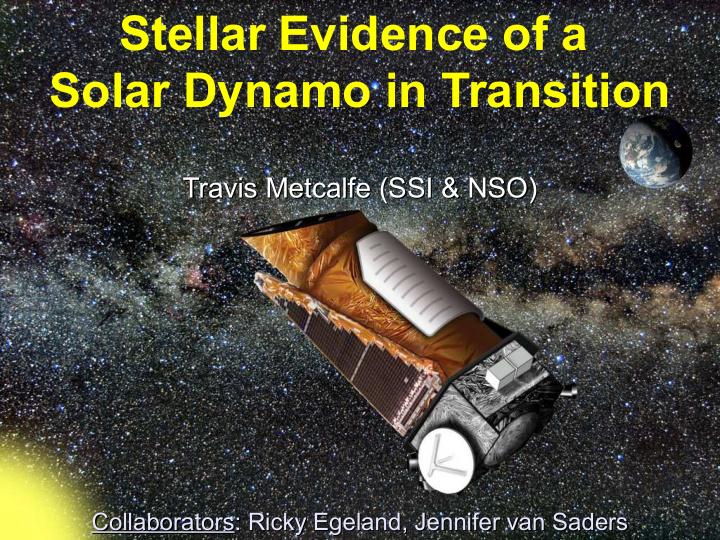



Stellar Evidence of a Solar Dynamo in Transition Travis Metcalfe (SSI & NSO) Travis Metcalfe (SSI & NSO) Collaborators: Ricky Egeland, Jennifer van Saders : Ricky Egeland, Jennifer van Saders Collaborators
Breaking magnetic braking • Stars beyond middle-age rotate more quickly than gyrochronology predicts • Onset is earlier in F-type, 16 Cyg near solar age in G-type, later in K-type stars • Effect seems to appear beyond a critical Rossby number (Ro ~ 2) van Saders et al. (2016, Nature)
Rotation-activity relation 1.1 Gyr 1.7 Gyr Metcalfe et al. (submitted)
Differential rotation fast equator fast poles Gastine et al. (2014)
Vaughan-Preston gap Vaughan & Preston (1980); Wright (2004)
Spots and faculae faculae dominated spot dominated Lockwood et al. (2007)
Solar analogs HD 20630 HD 30495 HD 76151 18 Sco 16 Cyg Metcalfe et al. (submitted)
Zeeman Doppler imaging 18 Sco HD 76151 HD 76151 18 Sco Petit et al. (2008)
Zeeman Doppler imaging • Young solar analog is dominated by a dipole (80% of poloidal field) • Dipole (35%) is already disappearing in 18 Sco, with 55% in quadrupole • Old solar analog has no Zeeman signatures, weak average line-of-sight field Petit et al. (2008, + priv. comm.)
Stellar activity cycles 18 Sco HD 20630 HD 76151 HD 30495 Saar & Brandenburg (1999); Böhm-Vitense (2007); Hall et al. (2007); Metcalfe et al. (2010, 2013); Egeland et al. (2015)
Summary • A change in differential rotation at Ro ~ 1 pushes stars across the V-P gap, rapidly decreases spot area, then disrupts magnetic braking at Ro ~ 2 • The Sun is in a transitional evolutionary phase, and its 11-year activity cycle may represent a special case of stellar dynamo theory • Future ZDI measurements, more constraints on differential rotation, and asteroseismology of the Mount Wilson sample will help test this scenario More details on arXiv:1606.01926
Recommend
More recommend